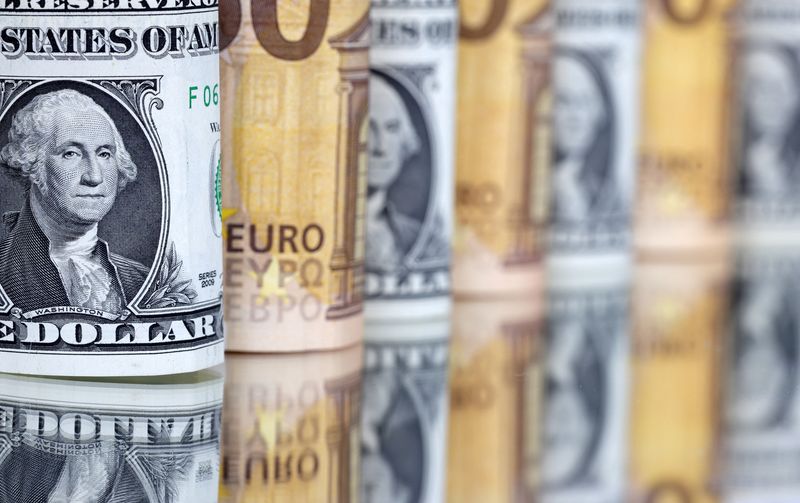By Herbert Lash
NEW YORK (Reuters) -The dollar meandered on Thursday after U.S. jobless claims rose more than expected last week, indicating a cooling labor market that could prompt the Federal Reserve to cut interest rates in early 2024 as it tries to engineer a soft landing.
The dollar index, a measure of the U.S. currency against six peers, edged higher 0.08% as a slowing U.S. economy leads the market to perceive the Fed is done raising rates.
Conversely, the euro strengthened 0.02% to $1.0848 after it jumped 1.69% on Tuesday, its biggest single-day percentage gain since November 2022.
Claims for state unemployment benefits rose 13,000 to a seasonally adjusted 231,000 for the week ended Nov. 11, the Labor Department said. Economists polled by Reuters had forecast 220,000 claims for the latest week.
The dollar plunged on Tuesday, also registering its biggest single-day decline in a year, after data on consumer prices came in softer than expected and increased the outlook for many that inflation was quickly decelerating to the Fed's 2% target.
The dollar rebounded a touch on Thursday as the market wrestled with the uncertainty of when the Fed might cut its overnight lending rate of 5.25%-5.5%, which is still restrictive to economic growth.
"We've long been in the camp of anticipating faster Fed easing than what the market has been pricing in," said Vassili Serebriakov, FX strategist at UBS in New York, adding UBS economists are forecasting a possible rate cut by the end of the first quarter in 2024.
"But there is still a number of reasons why the dollar is not going to weaken very quickly, the main one being the growth picture outside of the U.S. is still quite weak," he said.
Traders remain confident that rates will not go higher, with futures now pricing 1-in-3 odds for a first reduction by March, according to the CME Group's (NASDAQ:CME) FedWatch Tool.
Karl Schamotta, chief market strategist at Corpay in Toronto, said while markets anticipate a rapid Fed pivot towards rate cuts in 2024, historically speaking for that to occur there has to be a big hit to the economy.
"The challenge here is how we reconcile the view of a soft landing with rapid and significant rate cuts in 2024?" he said. "My view would be that at this point, markets are moving too fast ... and as a result, the U.S. dollar could outperform relative to expectations in early 2024."
Deutsche Bank (ETR:DBKGn) strategist Jim Reid on Thursday cited research from his bank's economists that showed in the last two years, this is the seventh occasion on which markets have priced in a swift shift by the Fed to rate cuts. On the previous six, those expectations entirely unwound.
"At some point there will be a dovish pivot, and this could be closer than the others to it, but be wary that we've now been to this well seven times in two years," Reid said.
Among other major currencies, the Japanese yen strengthened 0.47% at 150.66 per dollar. Earlier in the week the yen slid to a one-year low of 151.92.
"As far as dollar-yen is concerned, the market still has a bias to buy the dip in the short run because the volatility hasn't been very high and intervention has not materialized so far," Serebriakov said.
Sterling was last trading at $1.2406, down 0.10% on the day.

Elsewhere, the Aussie eased 0.6% to $0.6465, while the New Zealand dollar fell 0.85% to $0.5974.
The Australian currency failed to draw support from a strong rebound in employment, as traders keyed in on the fact that gains were mostly in part-time labor, while the jobless rate actually ticked higher.